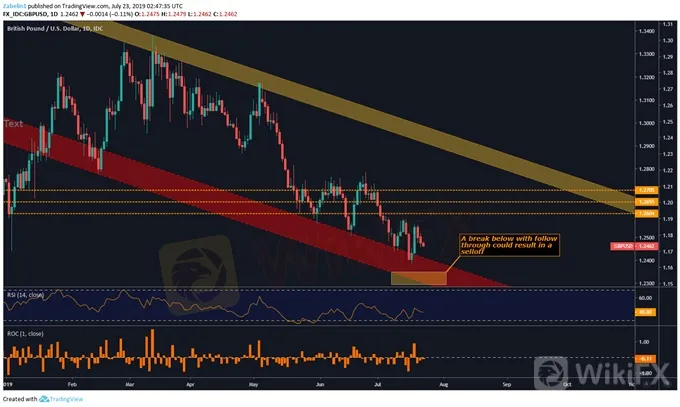简体中文
繁體中文
English
Pусский
日本語
ภาษาไทย
Tiếng Việt
Bahasa Indonesia
Español
हिन्दी
Filippiiniläinen
Français
Deutsch
Português
Türkçe
한국어
العربية
USD May Rise on IMF Economic Outlook, GBP Braces for New UK PM
Abstract:Sterling traders will be eagerly waiting for the announcement of the new UK Prime Minister while the US Dollar may rise after the IMF releases its updated economic outlook.
UK PRIME MINISTER, BREXIT, IMF ECONOMIC OUTLOOK, US DOLLAR – TALKING POINTS
US Dollar may rise if IMF report paints a gloomy picture for global growth
A new lawyer for the divorce: Sterling traders eye new UK Prime Minister
Brexit and IMF turbulence may stoke risk aversion and pressure GBPUSD
See our free guide to learn how to use economic news in your trading strategy!
The US Dollar and the British Pound may have a turbulent day tomorrow as Theresa May prepares to announce her successor and heir to the perils of Brexit while the IMFs publishes an updated World Economic Outlook. The report will likely be underscored by gloomy presentiments and in line with the previous release titled “A Weakening Global Expansion.”
Political contagion of protectionism and trade wars in the developed economies is now spreading to the developing world where inter-emerging market tensions are escalating against the backdrop of a slowing global economy. Furthermore, rising debt levels combined with the proliferation of collateralized loans with abysmal underwriting standards are conjuring a familiar specter, sending a chilling wind across financial markets.
Read more about how leveraged loans could collapse the global financial system.
Risk aversion linked to uncertainty stemming from Boris Johnson‘s approach to Brexit may push GBPUSD lower with the IMF’s publication amplifying risk aversion and the pairs decline. During times of uncertainty, investors place a premium on liquidity and divert capital to haven assets in an effort to mitigate losses. From the downward pressure of Brexit and a stronger USD, Cable may find itself breaking below critical support.
GBPUSD TECHNICAL ANALYSIS
Sterling traders will be biting their nails tomorrow amid a growing downside bias in light of the fundamental environment in the UK. GBPUSD has tested the resistance-turned-support channel before, though the quick bounce back is telling. However, the case for a break below key support exhorts traders to reconsider their trepidation in committing capital that supports a downward bias. In other words: downward pressure expected.
CHART OF THE DAY: CAPITULATION INEVITABLE?

Disclaimer:
The views in this article only represent the author's personal views, and do not constitute investment advice on this platform. This platform does not guarantee the accuracy, completeness and timeliness of the information in the article, and will not be liable for any loss caused by the use of or reliance on the information in the article.
Read more

KVB Market Analysis | 28 August: Yen Strengthens on BoJ Rate Hike Hints; USD/JPY Faces Uncertainty
The Japanese Yen rose 0.7% against the US Dollar after BoJ Governor Kazuo Ueda hinted at potential rate hikes. This coincided with a recovery in Asian markets, aided by stronger Chinese stocks. With the July FOMC minutes already pointing to a September rate cut, the US Dollar might edge higher into the weekend.

KVB Market Analysis | 27 August: AUD/USD Holds Below Seven-Month High Amid Divergent Central Bank Policies
The Australian Dollar (AUD) traded sideways against the US Dollar (USD) on Tuesday, staying just below the seven-month high of 0.6798 reached on Monday. The downside for the AUD/USD pair is expected to be limited due to differing policy outlooks between the Reserve Bank of Australia (RBA) and the US Federal Reserve. The RBA Minutes indicated that a rate cut is unlikely soon, and Governor Michele Bullock affirmed the central bank's readiness to raise rates again if necessary to combat inflation.

KVB Market Analysis | 23 August: JPY Gains Ground Against USD as BoJ Signals Possible Rate Hike
JPY strengthened against the USD, pushing USD/JPY near 145.00, driven by strong inflation data and BoJ rate hike expectations. Japan's strong Q2 GDP growth added support. However, USD gains may be limited by expectations of a Fed rate cut in September.

KVB Market Analysis | 22 August: Gold Stays Strong Above $2,500 as Fed Rate Cut Hints Loom
Gold prices remain above $2,500, near record highs, as investors await the Federal Open Market Committee minutes for confirmation of a potential Fed rate cut in September. The Fed's dovish shift, prioritizing employment over inflation, has weakened the US Dollar, boosting gold. A recent revision showing the US created 818,000 fewer jobs than initially reported also strengthens the case for a rate cut.
WikiFX Broker
Latest News
What Makes Cross-Border Payments Easier Than Ever?
Trader Exposes Unethical Practices by STP Trading
Italian Regulator Warns Against 5 Websites
Currency Calculator


